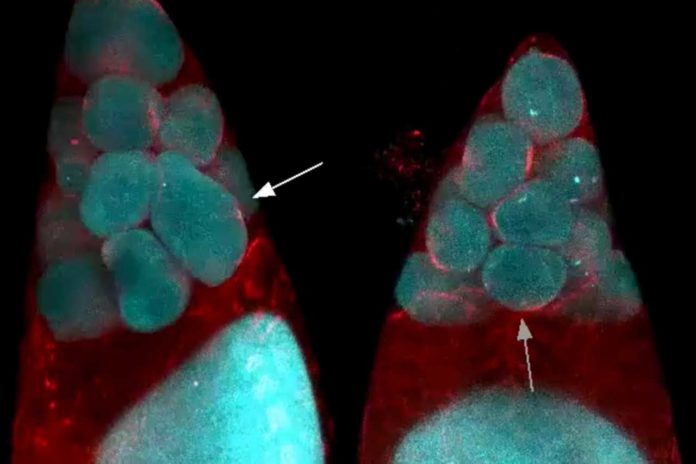The largest cell is the ovum in the human body. The ovum, also called the egg cell, is the female body’s reproductive cell and about 10,000 times larger than sperm cells.
The function of egg cells is to provide enough nutrients to support a growing embryo after fertilization, plus mitochondria to power all of that growth.
However, why they are so big remains obscure.
In a new study by a team of MIT biologists and mathematicians, scientists reveal the process through which the oocyte grows significantly and rapidly before fertilization. Scientists conducted the study in fruit flies and revealed that the process relies on physical phenomena analogous to the exchange of gases between balloons of various sizes.
Scientists have shown that the much larger oocyte’s nurse cells dump their contents into the larger cell. It is the same as the small air balloon releasing its air to a larger ballon when connected by small tubes in an experimental setup.
Jörn Dunkel, an MIT associate professor of physical applied mathematics, said, “The study shows how physics and biology come together, and how nature can use physical processes to create this robust mechanism. If you want to develop as an embryo, one of the goals is to make things very reproducible, and physics provides a very robust way of achieving certain transport processes.”
Eggs in female fruit flies develop inside a cell cluster known as cysts. To produce one egg cell and 15 nurse cells, an immature oocyte needs to undergo at least four cell division cycles. The cell separation is incomplete, and each cell remains connected to the others by narrow channels that act as valves that allow material to pass between cells.
Scientists started studying this process because of their interest in myosin, a class of proteins acting like motors and helping muscle cells contract. After performing high-resolution, live imaging of egg formation, they found that myosin plays a vital role in the second phase of the transport process.
In the starting phase, scientists were puzzled to know the cells did not appear to be increasing their contractility at all. It means a mechanism other than “squeezing” was initiating the transport.
Adam Martin, an MIT associate professor of biology, said, “The two phases are strikingly obvious. After we saw this, we were mystified because there’s not a change in myosin associated with the onset of this process, which is what we were expecting to see.”
Scientists later develop a model to understand better how cell contents are transferred from the 15 small nurse cells to the large oocyte. The nurse cells closest to the oocyte transfer their contents first, followed by the cells in more distant layers.
Graduate student Nicolas Romeo said, “After I spent some time building a more complicated model to explain the 16-cell problem, we realized that the simulation of the simpler 16-balloon system looked very much like the 16-cell network. It is surprising to see that such counterintuitive but mathematically simple ideas describe the process so well.”
“The first phase of nurse cell dumping appears to coincide with when the channels connecting the cells become large enough for the cytoplasm to move through them. Once the nurse cells shrink to about 25 percent of their original size, leaving them only slightly larger than their nuclei, the second phase of the process is triggered, and myosin contractions force the remaining contents of the nurse cells into the egg cell.”
Martin said, “In the first part of the process, there’s very little squeezing going on, and the cells shrink uniformly. Then this second process kicks in toward the end where you start to get more active squeezing, or peristalsis-like deformations of the cell, that complete the dumping process.”
Through this study, scientists demonstrated how cells could coordinate their behavior using biological and physical mechanisms to bring about tissue-level behavior.
Journal Reference:
- Jasmin Imran Alsous et al. Dynamics of hydraulic and contractile wave-mediated fluid transport during Drosophila oogenesis. DOI: 10.1073/pnas.2019749118
